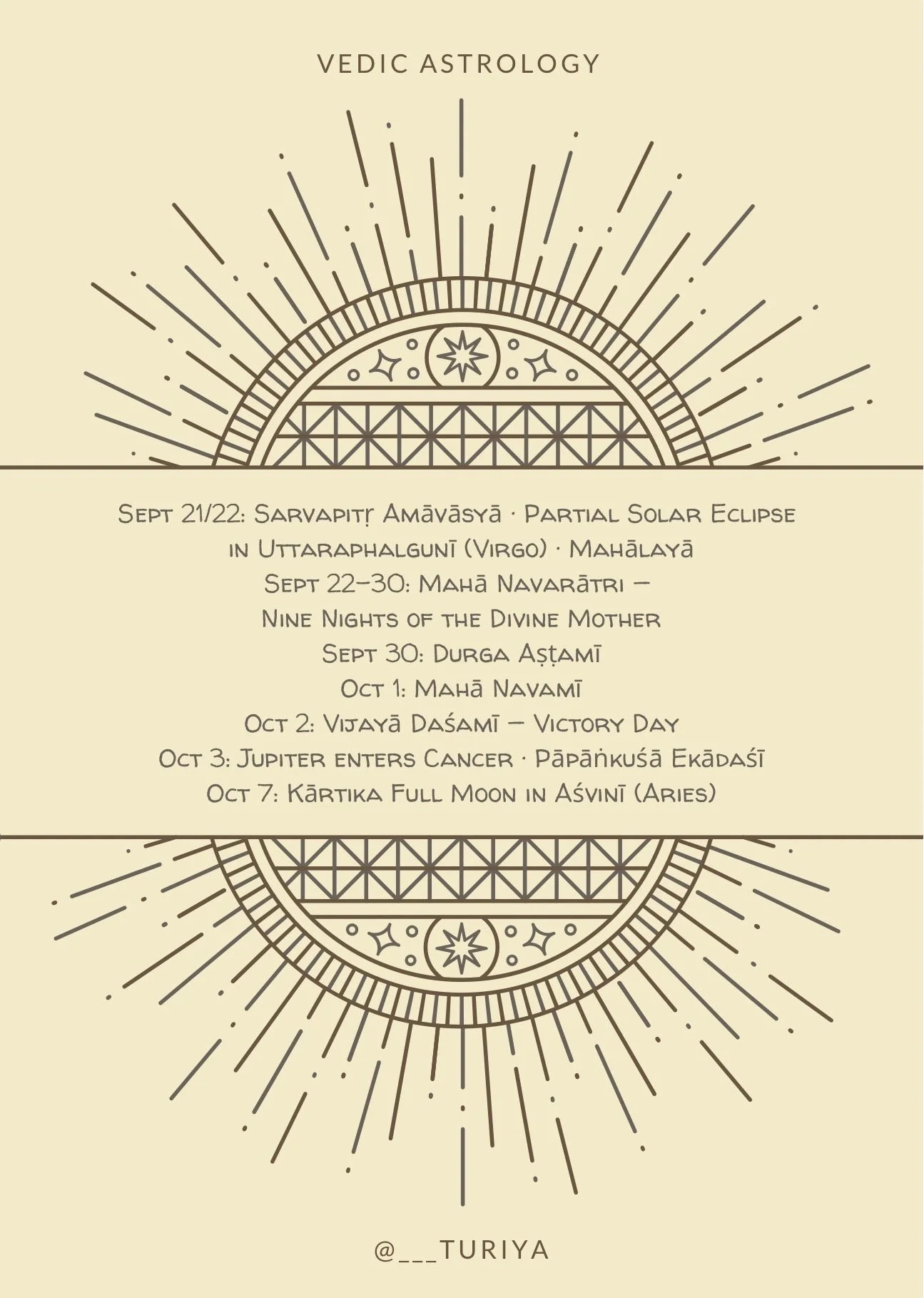Taking the month of Kārtika Māsa off of social media and am now extending through next year.
Please visit here to book a reading
VIDYĀ & CHAI 🦢 | October 19th | 8am PST
RSVP to tulsibagnoli@gmail.com
Your Custom Text Here
BLOG: Pulse of the Stars

ArtworkL British Museum
Taking the month of Kārtika Māsa off of social media and am now extending through next year.
Please visit here to book a reading
VIDYĀ & CHAI 🦢 | October 19th | 8am PST
RSVP to tulsibagnoli@gmail.com
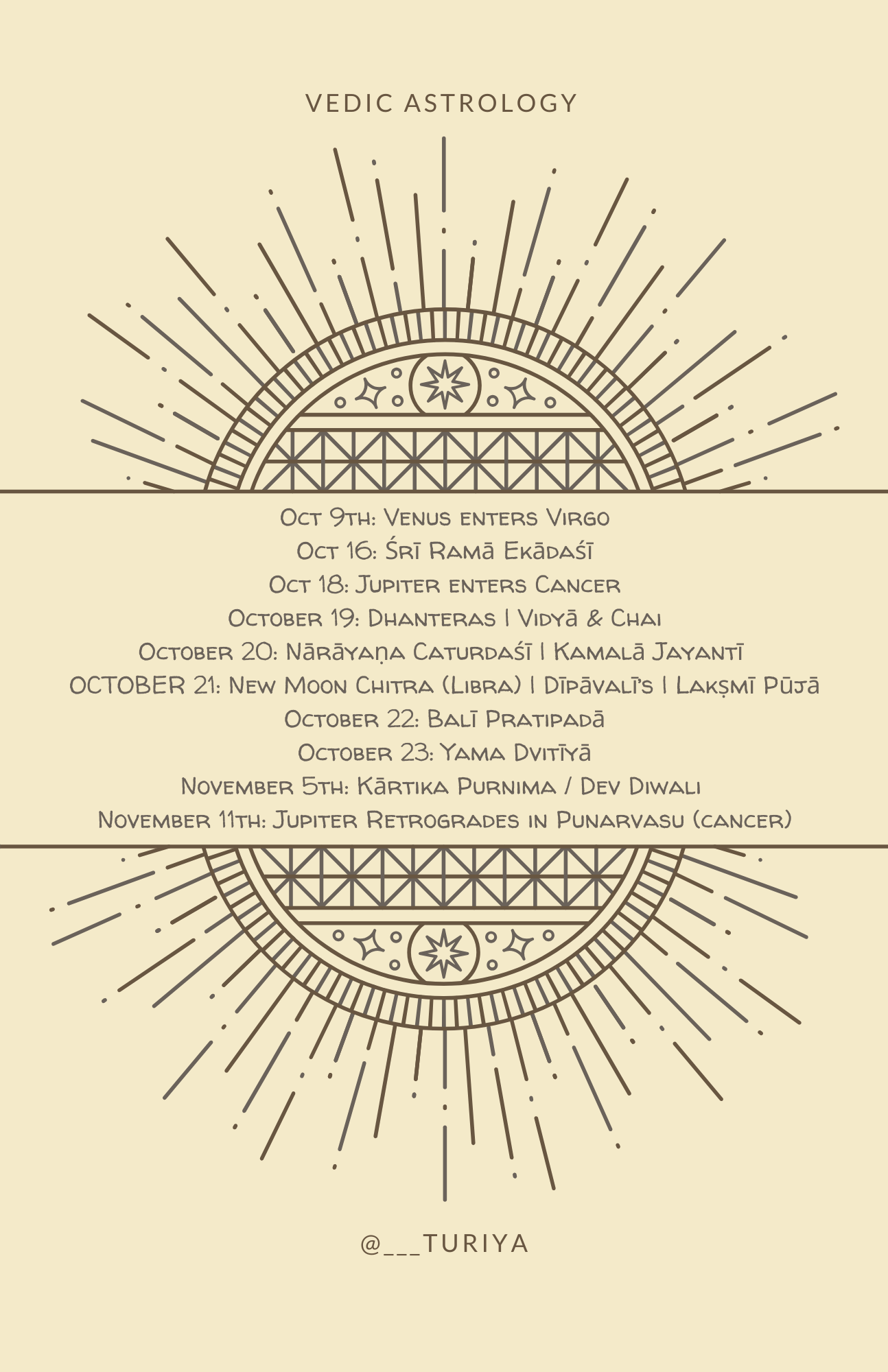
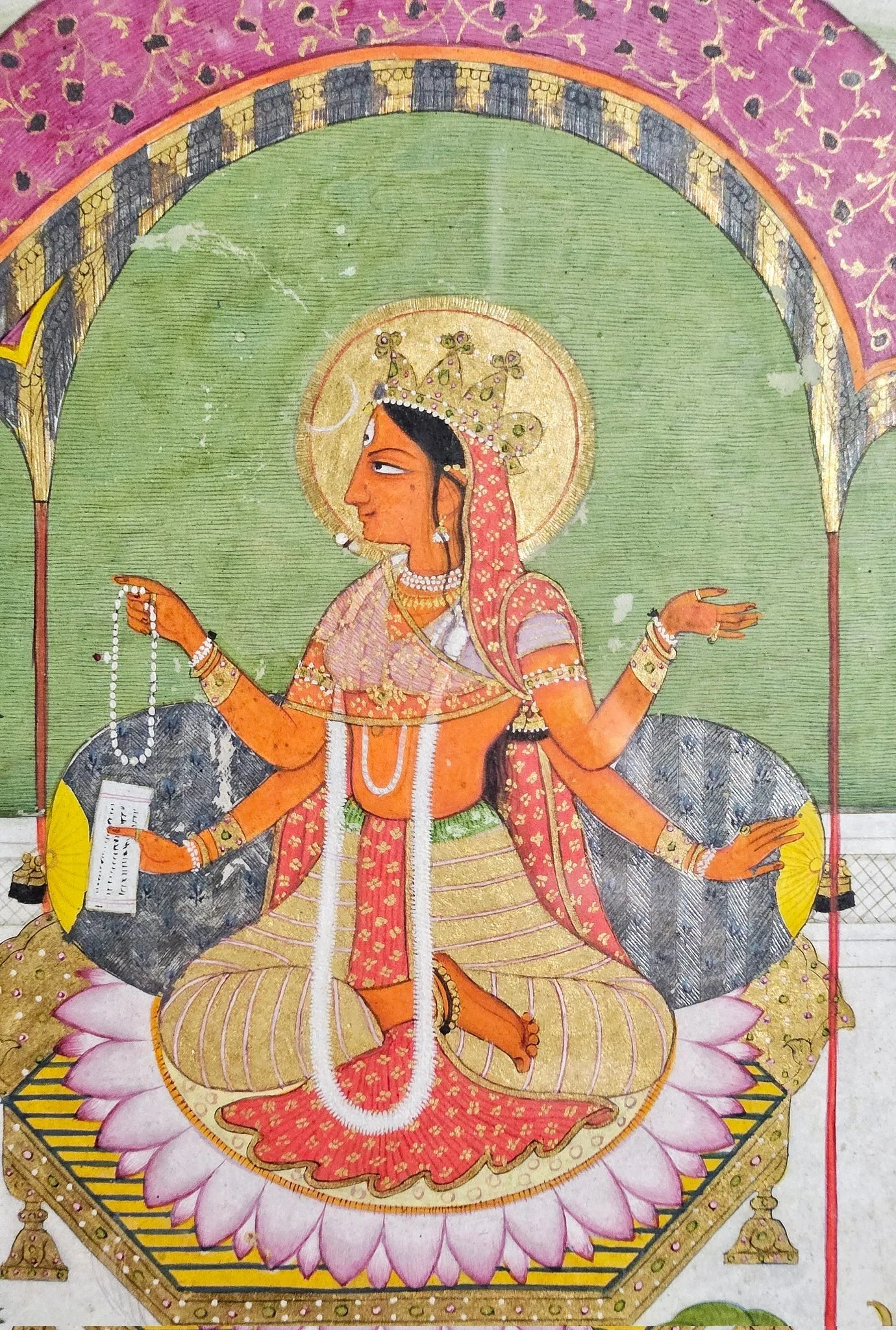
Artwork: Śrī Lalitā–Tripurasundarī | the most beautiful manifestation of the most beautiful Goddess- Pārvatī. Pandit Seu-Nainsukh family workshop, Guler. Late 18thC
Śarad Navarātri शरद् नवरात्रि commences on the tithi after the new moon, from Pratipadā tithi (1st lunar day) to the Navamī tithi (9th) of the Shukla Paksha (waxing moon) in the month of Aśvina (setp/oct). This nine day festival marks the end of monsoon season, the transition into autumn, and is the most celebrated of the four yearly Navarātris.
The word Navarātri means "nine nights" in Sanskrit, nava meaning "nine" and rātri meaning "nights." During these nine nights and ten days of devotion, nine different forms of goddess Durgā (navadurgā), also known as Śakti are worshiped. The tenth day is commonly referred to as Vijayā-Daśamī or Dussehra, celebrating the victory of good over evil.
Today also marks the new moon of our ancestors Mahālaya Amāvásyā and the culmination of eclipse season. The veil is thin and we find ourselves standing at the threshold of irreversible change. The solar eclipse was in the constellation of Uttaraphalgunī (Virgo), who holds the śakti of prosperity and the accumulation of wealth through partnership — initiating a powerful window and six months for collaboration that ignites a fresh perspective and creative growth.
The rose colored glasses have come off and you may be finding new parts of yourself and your life being revealed to you now. A balancing act between self and other. Be willing to lean all the way in and release entertaining what’s no longer for you, so you can step powerfully into this new timeline with intentional action.
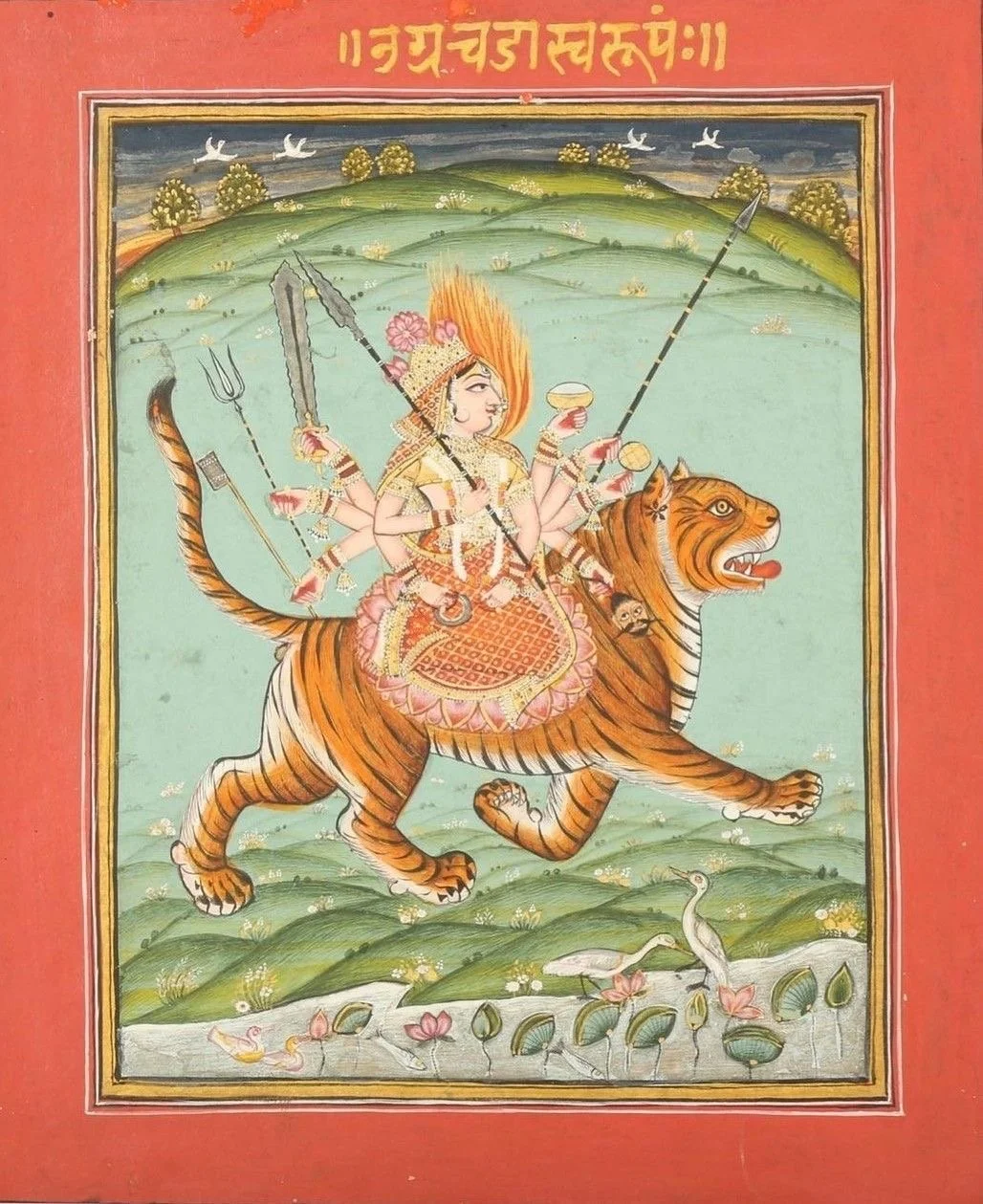
Artwork: Pinterest
Navarātri invokes an internal quest to locate and establish our seat within the center of the heart of the Goddess. In a world that grasps our attention and seize our mind to look outside of ourselves to seek truth, validation and even to gain a so called glimpse of the goddess - this festival calls us to go deeper within to attune with her rivers that flow within us and to cultivate a direct experience, and personal relationship with Her.
Devī is that awakening force, that primordial energy that lives within us and awaits our attention. Yoga teaches us that whatever we put our attention on grows stronger in our lives. Move beyond your ideas of who she is and how she can be reached.
This window is ripe for putting into physical practice the teachings found in the yoga śāstra. In the quieting of our mind (yogaś-citta-vr̥tti-nirodhaḥ) and the investigation of all that lies below the surface — in the observation and embrace of both our shadows and our light, which are ultimately one and the same — we’re being called now to enter into that space, and to transcend.
As we tend to śakti, and begin to establish a firm foundation in Her, we begin to awaken our power to focus, to cultivate our dhāraṇā and draw all our energies inside — this continued focus is the active meditation requesting our attention — calling us to become completely absorbed in Her.
She is the embodied meant of all that is and ever will be, She is our very breath and that which gives life to all, yet she cannot be reached by contemplation or intellectual understanding and philosophizing, or even described through words, she can only be touched through direct experience — that which requires digestion and stabilization to be truly lived. Can you answer that call?
The nine names of manifestation have been spoken in the Devīmāhātmyam DevĪ Kavacaṃ, by the Lord Brahmā (the creator) Himself:

Artwork: Pinterest
"First is Goddess Śailaputrī, the Daughter of the Himālayas, and second is Brahmachāriṇī, She who observes the vow of celibacy, the Goddess of sacred study and penance; third is Chandraghaṇṭā, the Goddess of the Delight of Practice, who bears the moon in her necklace, Kūṣmāṇḍa, the Goddess of Purifying Austerity is fourth.”
“Fifth is the Goddess Skanda-Mātā, the mother of Skanda, born out of her powers, sixth is Kātyāyanī, the One Who is Ever Pure; seventh is Kālarātrī, the Goddess of the Dark Night of Overcoming Egotism, Siddhidātrī, Mahāgaurī, the wife of Lord Śiva is eighth.”
“Ninth is the Goddess Siddhidātrīm, the provider of Siddhis, and bestower of mystic powers; the nine Durgas, relievers of difficulties, have been enumerated, and these names have been revealed by the great soul of the Supreme Brahmā himself."
ॐ दुं दुर्गायै नमः
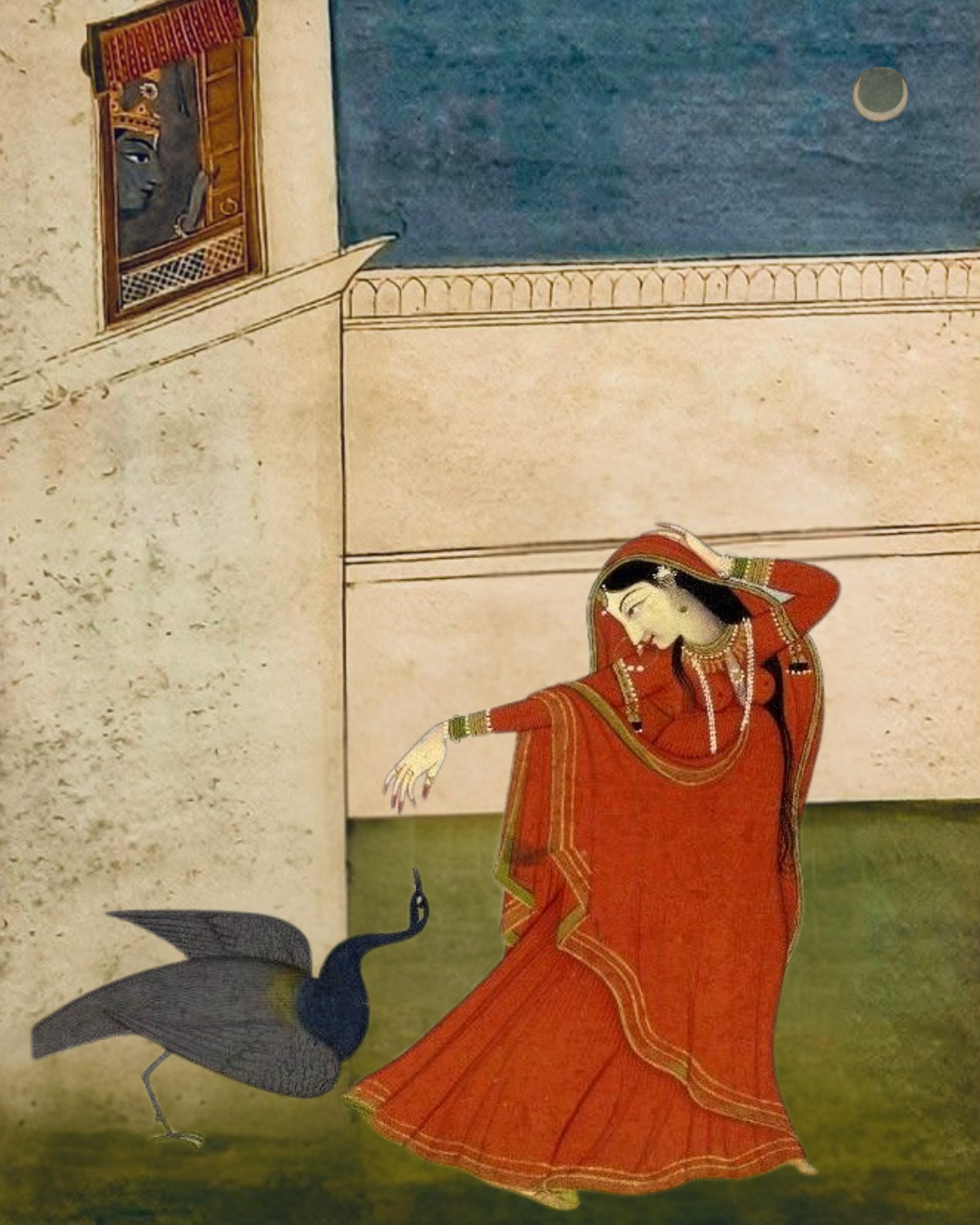
Edit by @___turiya
SOLAR ECLIPSE सूर्य ग्रहण
Eclipse season culminates with the new moon (amāvásyā) and a partial solar eclipse (Sūrya Grahaṇam) in the Vedic Lunar mansion of Uttaraphalgunī उत्तरफल्गुनी (Virgo), the star of Patronage.
This new moon is also known as Sarvapitṛ Amāvāsyā which concludes Pitṛ Pakṣa (fortnight of the ancestors), also called Mahalaya Amāvāsyā, when oblations can be offered to all ancestors (sarva-pitṛ), especially for those who may have been forgotten or for whom individual śrāddha has not been performed.
Solar eclipses are omens for the energies to come. Track what has been trying to make itself known to you in the past few weeks. They expose what is hidden and set the tone for the next six months. A spiritual culmination unfolds, signaling transformative endings and the potential for new beginnings.
Right now, we’re in a time outside of time, where things aren’t what they seem.
The eclipse portal has delivered confrontation with the unknown as promised and continues to bring old patterns to the surface for transmutation. Don’t touch what’s coming up.
Uttaraphalgunī calls us to build authentic connections through acts of service, generosity, and mutual support. As the patron of contracts and agreements, this asterism, steeped in the qualities of hospitality and protection, encourages us to honor our commitments and nurture relationships that foster both personal and collective growth.
Holding the energy and śakti of prosperity and the accumulation of wealth through partnership, this is a powerful window for collaboration that ignites a fresh perspective and creative growth.
With the responsibility of breathing life into new architecture, we become most in need of balance. The fine tuning point between self and other — anchoring into and committing fully to self sovereignty, while practicing the grace of presence and participation within this co-created dream.
You can only change and work on yourself. No matter how deeply you feel the need to hold on or piece together something that is unraveling, you may not be able to. Allow yourself to be surprised. This is an opportunity for profound growth—don’t bypass it simply because it’s uncomfortable. Observe what is unfolding and step powerfully into taking responsibility for your own spiritual evolution.
Accelerated spiritual growth awaits if we allow introspection. Some pattern has been attempting to reveal itself for completion and healing. What would it take for you to stop resisting that which you don’t prefer? Welcome it all—the beauty, the terror, the rapture, and the turbulence. Be with it and let it go. It may not be comfortable or easy, but it will undoubtedly be worth it.
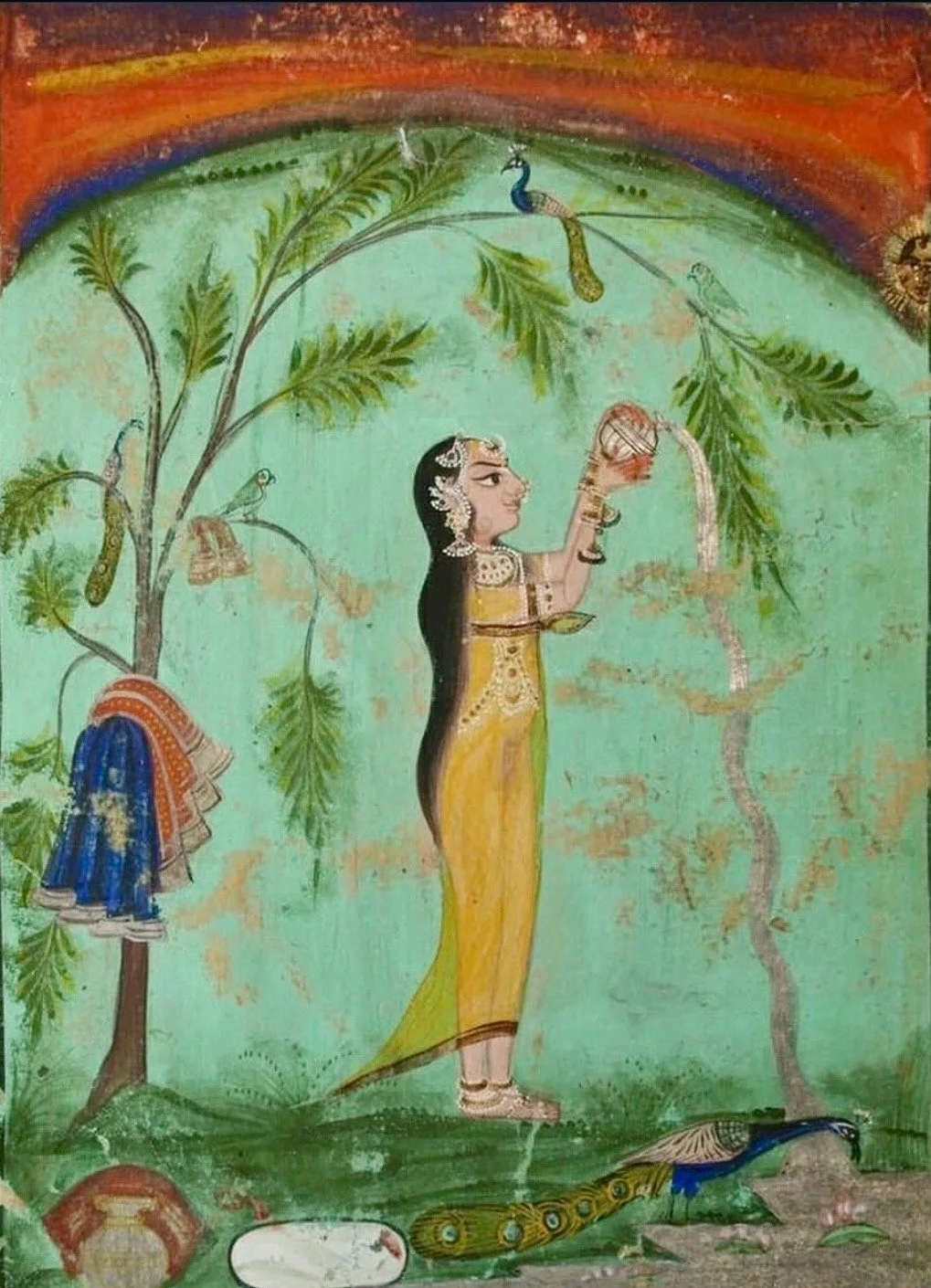
Eclipses stir duality to initiate purification, a necessary process through which self-knowledge is deepened and stabilized. The turbulence you may feel is part of the alchemy drawing you deeper into your own psyche.
Know there is light at the end of the tunnel—keep going. Do yourself a favor and create space to delve deeper into what you may have been resisting. Release what you desire and realign with what is in right relationship and highest alignment.
In this phase of heightened impulsivity, keep life simple, stay grounded, and rest. Reflect on what’s being revealed and what needs untangling. Expect the unexpected.
The ancients taught that any practice undertaken during an eclipse bears fruit a thousandfold. In this sacred window, they consumed less—physically and mentally—to keep their channels clear. With the Sun and Moon—our sources of prāṇa—obscured, this becomes a potent time for:
Mantra chanting
Meditation & breathwork
Prayer & fasting
Turning inward, rather than outward
It is also recommended to bathe before and after the eclipse to cleanse both body and mind, allowing for a smoother energetic transition.
Trust that this cycle serves as an initiation, sowing the seeds of transformation that will blossom in divine timing, guiding you into the next phase of your journey. Take your time to process things and allow the story to continue unfolding.
Those in a dasha or sub-period of Saturn, or with natal planets (Sun, Moon, Rising) in Uttaraphalgunī, will experience this transit’s transformative energy even more profoundly….
All My Relations 🦚
We will be diving deeper together in our monthly Vidyā & Chai: Group meditation and Sacred Storytelling
September, 22nd 1:30pm pst 🦢☽☼

Partial Solar Eclipse: New Moon in Uttaraphalgunī (Virgo)
Sept 21st 2025 12:54 PM PST | Sept 22nd 1:24 am IST
Eclipse Timing:
Sept 21st 10:29 am PST - Sept 21st 14:53 pm PST
Sept 21st 22:59 pm IST - Sept 22nd 3:23 am IST
